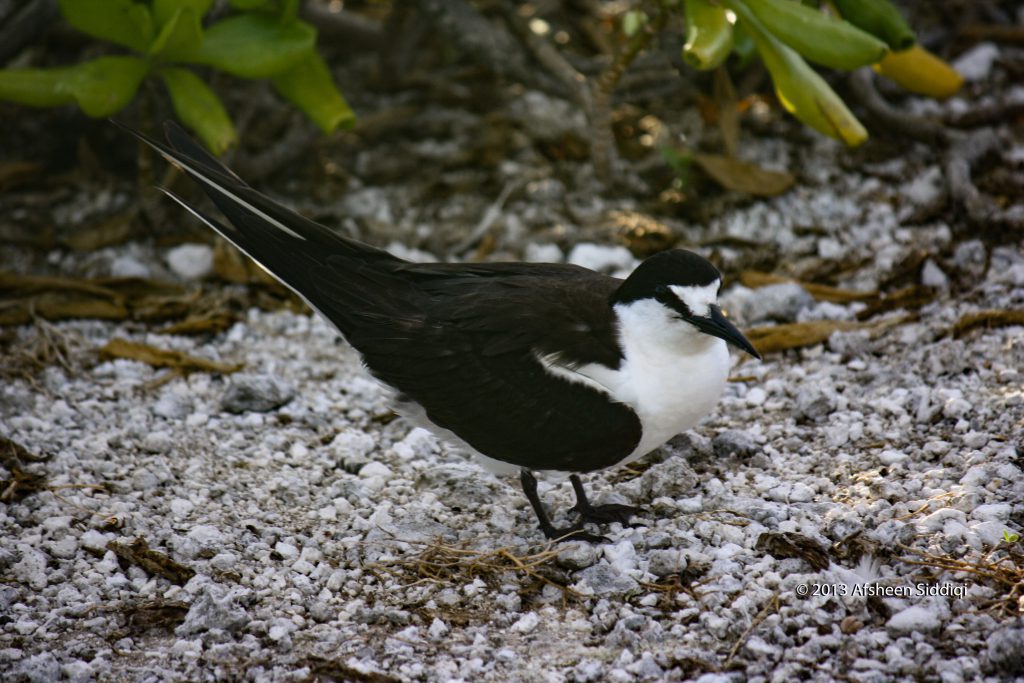ʻEwaʻewa – Sooty Tern
Sterna fuscata
| Stated-recognized | Indigenous |
| NatureServe Heritage Rank | Secure |
| North American Waterbird Conservation Plan |
Moderate Concern |
| Regional Seabird Conservation Plan |
USFWS 2005 |
| Stated-recognized | Indigenous |
| NatureServe Heritage Rank | Secure |
| North American Waterbird Conservation Plan |
Moderate Concern |
| Regional Seabird Conservation Plan |
USFWS 2005 |

The ‘ewa‘ewa or sooty tern is an abundant and gregarious tern (Family: Laridae) with a pantropical distribution, and is able to remain on the wing for years. Eight ‘ewa‘ewa (sooty tern) subspecies are recognized, and one (S. f. oahuensis) breeds in Hawai‘i. Individuals have long, slender wings and a deeply forked tail. Adult males and females are blackish above, except for white forehead and white on the edges of the outer most tail feathers, and entirely white below. The sharp bill, legs, and feet are black. Flight is characterized by powerful flapping, gliding and soaring, capable of long distance migration and breeding adults remain aloft between breeding seasons.
Generally forages in large mixed species feeding flocks, typically feeding over schools of predatory fishes, especially yellowfin tuna (Neothunnus macropterus) and skipjack tuna (Katsuwonus pelamis). ‘Ewa‘ewa (sooty tern) feed primarily by seizing prey from the water or air while on the wing, infrequently by shallow dives; species’ plumage has poor waterproofing and easily becomes waterlogged. In Hawai‘i, ‘ewa‘ewa (sooty tern) diet consists of squid, goatfish, flyingfish, and mackerel scad.
Nests in large, dense colonies consisting of thousands to a million pairs of terns. Individuals return to natal colony to breed, some long-term pair bonds have been documented, and breeders prefer to return to previous nest locations. Nests are shallow scrapes often lined with bits of shell or vegetation. Timing of breeding varies among years and locations, even within Hawai‘i, but generally eggs are laid beginning of February and most birds fledge by July. Both parents incubate single egg and brood and feed chick. Parents continue feeding young for two weeks after fledging and young remain aloft until they return to breed. Birds first breed between four and ten years of age and the oldest known individual was 32 years old.
‘Ewa‘ewa (sooty tern) breed throughout the NWHI and on Moku Manu off of the island of O‘ahu. Outside of Hawai‘i, ‘ewa‘ewa (sooty tern) breed on most islands throughout the world’s tropical oceans. Outside the breeding season, ‘ewa‘ewa (sooty tern) are highly pelagic.
‘Ewa‘ewa can be found in dense colonies in many areas of Green Island. The majority of the colonies are located in multiple areas on the North end of the island with a few along the runway as well. Easily spotted, Sooty terns congregate in large flying masses. Sooty terns are ground nesters, with little to no habitat preference.
The following management goals are important to Pacific seabird conservation: maintain, protect, and enhance habitat; eradicate or control non-natives; minimize bycatch and other negative effects of fishing; improve the effectiveness of oil spill response efforts; identify contaminates and hazardous substances; and minimize the effects of powerlines, towers, wind turbines and lights (USFWS 2005). The goal of these management actions is not only to protect seabird populations and their breeding colonies, but also to re- establish former breeding colonies thereby reducing the risk of extinction. In addition to these efforts, future management specific to Hawaiian populations of ‘ewa ‘ewa (sooty terns) should include the following:
Eradication and control of introduced predators at current and potential nesting sites. Continued protection and management of existing wildlife sanctuaries and refuges.
Historically, wanton killing for feathers (i.e., millinery trade) greatly reduced populations. Populations extirpated from Johnston, Wake, and Marcus islands by Japanese feather hunters at the turn of the last century are only recently being recolonized. Untold numbers were killed as a result of military activities in the Pacific during World War II. Between 1954 and 1964, 54,000 albatross were killed on Midway to reduce the risk of collisions with aircraft. In 1909, 300,000 birds were killed on Laysan Island. Prior to banning drift net fisheries in 1993, thousands were killed annually. In the 1990s, longline fisheries killed thousands annually.
Like all seabirds, adults and nests are susceptible to predation by rats (Rattus spp.) and feral cats (Felis silvestris). All sites in NWHI are free of rats and cats.
Because ‘ewa‘ewa (sooty terns) rely on predatory fish to drive prey to the surface, overfishing may eventually affect Hawaiian populations.
‘Iwa or great frigatebirds (Fregata minor), cattle egrets (Bubulcus ibis), ‘akekeke or ruddy turnstones, (Arenaria interpres) ‘auku‘u or black-crowned night herons (Nycticorax nycticorax), Laysan (Telespiza cantans) and Nihoa (T. ultima) finches will depredate eggs and chicks.
‘Ewa‘ewa (sooty terns) populations are vulnerable to oil spills.
Oʻahu maka ʻewaʻewa, Oʻahu with indifferent eyes [a term of reproach to Oʻahu people, said to have been said by Hiʻiaka when her Oʻahu relatives refused to help her mend a canoe for a journey to Kauaʻi]. ʻAʻole anei ʻewaʻewa ʻole ko ʻu mau ʻaoʻao? ʻAʻole anei ʻo kō ʻoukou mau ʻaoʻao ka i ʻewaʻewa? (Ezek. 18.25) Is not my way just? Are not your ways unjust? Hoʻokō au ia kauoha me ka ʻewaʻewa ʻole (Kel. 125), I carried out this instruction without a flaw.
1. Redup. of ʻewa 1; irregular, biased, unequal, unjust. Maka ʻewaʻewa ʻia, looked at with disfavor, eyed askance.
2. n. Sooty tern (Sterna fuscata oahuensis); forehead and sides of head white, rest of head black; upper parts black, white beneath. Also ʻewaʻewa iki.